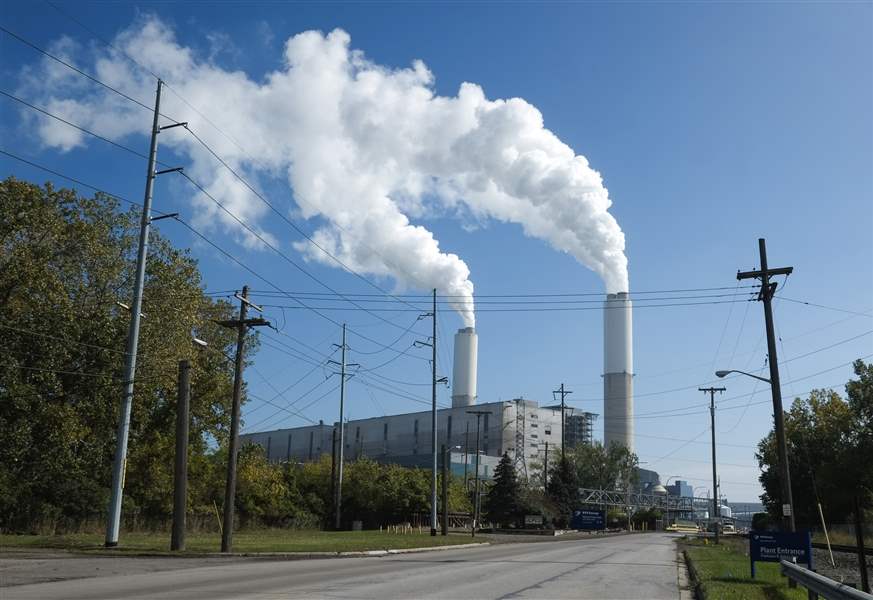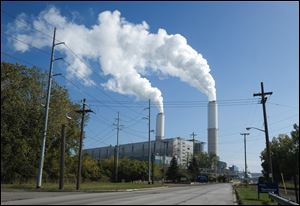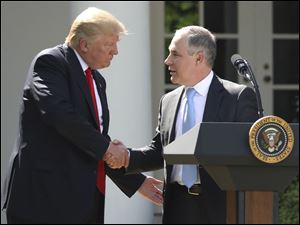
Industry leaders say coal-fired power plants becoming obsolete
10/20/2017
The DTE Monroe Power Plant on Oct. 13. DTE's renewable energy director says that market forces are so strongly in favor natural gas and renewable energy that it makes no economic sense for utilities to invest in coal.
THE BLADE/ANDY MORRISON
Buy This Image
MONROE — Although the Trump administration announced the nation’s so-called “war against coal is over,” Michigan’s largest utility believes there’s no future left for such a dirty, carbon-dense fuel and is making plans to phase out all of its coal-based energy production within 23 years — including its massive coal-fired power plant in Monroe, one of America’s largest.
Matthew Wagner, DTE Energy renewable energy director, told attendees of the 27th annual Society of Environmental Journalists conference in Pittsburgh earlier this month that market forces are so strongly in favor natural gas and renewable energy now it makes no economic sense for utilities to invest more heavily in coal and nuclear power.

The DTE Monroe Power Plant on Oct. 13. DTE's renewable energy director says that market forces are so strongly in favor natural gas and renewable energy that it makes no economic sense for utilities to invest in coal.
By 2040, DTE will get zero percent of its electricity from coal, Brian Corbett, DTE spokesman, said.
Mr. Wagner said that America’s existing fleet of coal-fired power plants are antiquated and have outlived their usefulness.
He was one of several speakers who — despite the Trump administration’s support of coal — said there’s no going back to coal’s glory days, when it generated more than half of America’s electricity for decades.
Mr. Wagner compared coal-fired power plants to high-mileage used cars that — after years of upgrades and repairs — ultimately reach a point in time in which they must be replaced.
During the question-and-answer session, he told a Blade reporter his remarks included DTE’s massive coal-fired power plant in Monroe, where the utility invested $1 billion in pollution controls over a decade.
Because that modernization work was completed only three years ago, the Monroe plant — one of the nation’s largest coal burners — will undoubtedly be the last DTE retires, he said.
“It's a fantastic plant. It's one of the best plants in the country,” Mr. Wagner said of the Monroe facility. “But at some point, it just won't be cost-effective to run that any longer.”
The reductions are part of an overall commitment announced earlier this year by DTE Chairman and Chief Executive Officer Gerard M. Anderson to have that utility reduce its carbon footprint 80 percent over 2005 levels by 2050, Mr. Wagner said.

Another major utility in this region, Akron-based FirstEnergy Corp., told The Blade it plans to be even more aggressive by reducing its carbon footprint 90 percent over 2005 levels by 2045.
Natural gas-fired power plants emit climate-altering carbon dioxide and other greenhouse gases, but not nearly to the extent of coal-fired power plants.
DTE now has 13 wind parks and 31 solar arrays across Michigan that collectively generate about 10 percent of the utility’s power.
“Wind right now is just the biggest bang for the buck in terms of renewable energy,” Mr. Wagner said.
Peter Kelley, America Wind Energy Association vice president of public affairs, said it’s a myth to believe renewable energy is embraced only by liberals.
More than 80 percent of America’s wind turbines in operation now are in Republican districts. And 88 percent of the newest wind turbine capacity is in states that voted for Mr. Trump, he said.
The reason is simple. “Renewables are getting cheaper while fossil fuels are getting more expensive,” Mr. Kelley, a speaker on the same SEJ panel as Mr. Wagner, said.
President Trump campaigned on bringing back coal jobs. Even the Kasich administration — critical of Mr. Trump on many other policy initiatives — applauded him for scrapping the highly controversial Clean Power Plan. Ohio Environmental Protection Agency spokesman Heidi Griesmer sounded almost proud during a recent radio interview when she said that agency immediately shelved state implementation when the Supreme Court issued a stay in 2016.
The Clean Power Plan was a cornerstone of former President Barack Obama’s efforts to combat climate change. It called for extreme tightening of rules for coal-fired power plants, the largest source of climate-altering emissions.
“The war against coal is over,” U.S. EPA Administrator Scott Pruitt, who fought the Clean Power Plan as an elected attorney general of Oklahoma, told coal miners in Kentucky last Monday in announcing the dismantling of Mr. Obama’s plan.
But Mr. Wagner said DTE’s “planning horizons are too big to shift when politics change in Washington.”
“Our coal plants are getting old,” Mr. Wagner said. “It's kind of like an old used car. By 2040, we’ll be retiring more coal plants. We appreciate Trump is trying to bring coal back in some ways, but it doesn't make our utilities any younger. ... We, out of necessity, have to be thinking long term.”
As recently as 2005, 78 percent of DTE’s electricity came from coal. That figure was down to 60 percent in 2016.

President Donald Trump shakes hands with EPA Administrator Scott Pruitt after pulling the United States from the Paris climate change accord.
By 2050, DTE expects to have 40 percent of its power coming from natural gas, 30 percent from wind, and 20 percent from nuclear, and 10 percent from solar.
Many businesses “are interested in knowing these days that a good portion of their electricity is coming from renewables,” Mr. Wagner said.
It is not clear how DTE will continue getting such a large percentage of its electricity from nuclear in 2050, given that its Fermi 2 operating license expires in 2045. Nuclear accounted for 18 percent of its generation in 2005, with natural gas a mere 3 percent, and wind only 1 percent.
John Austerberry, DTE spokesman, said the utility has no plans to close Fermi 2 early despite the high-profile difficulties nuclear is having competing against natural gas and other forms of power nationally.
He said that plant is not struggling as much as FirstEnergy’s Davis-Besse nuclear plant because Michigan’s regulatory environment “is significantly different than Ohio’s and, consequently, Fermi is not facing similar economic challenges.”
But DTE also continues to maintain it has no plans to follow through and build a Fermi 3 nuclear plant, despite spending $300 million to obtain a license to build it. The application costs were covered by the Energy Policy Act of 2005, when the former President George W. Bush’s administration enticed utilities to file for applications by offering up to $300 million in incentives.
Such a plant’s latest construction estimate, now several years old, is $10 billion — more than three times greater than the original cost estimate of $3 billion.
“We really did that for insurance,” Mr. Wagner said, explaining that the utility only wants to keep its options open in the event markets for natural gas and renewable energy take an unexpected downturn.
Meanwhile, Davis-Besse’s future remains in limbo.
FirstEnergy previously announced it will make a decision about the future of that plant and its massive coal-fired Sammis plant in southern Ohio by June, 2018. It is seeking a buyer or a significant change in market conditions to make them more economically viable. The utility has said for months that either or both could be closed soon if the situation doesn’t improve.
“We will continue with the strategic review of our competitive generating plants, which include Davis-Besse and Sammis, and will complete that process by mid-2018,” Stephanie Walton, FirstEnergy spokesman, said Friday.
She said FirstEnergy already is well on its way toward achieving its goal of a 90 percent reduction in climate-altering carbon dioxide emission below 2005 levels by 2045. To date, it has achieved a 40 percent reduction below 2005 levels, she said.
When FirstEnergy’s coal-fired electricity generation capacity peaked in 2011, coal-fired plants accounted for 64 percent of its generation capacity compared to about 55 percent today, Ms. Walton said.
The Trump administration’s decision to revoke Mr. Obama’s Clean Power Plan “does not change FirstEnergy's decision to exit competitive generation, which is based on challenges of operating in a competitive market.” she said.
The Sierra Club noted a milestone recently: With Luminant Energy announcing plans to close two more coal-fired power plants in central Texas, more than half of America’s coal plants — 262 of them — have retired or have been committed to retire since 2010. That surpasses the 261 plants that are still operating or not being scheduled for closure soon.
“It isn’t a question of when we replace America’s dirty, polluting coal fleet. It’s a question of how soon,” Michael Brune, Sierra Club executive director, said. “We can either choose to ignore the reality that the public has chosen clean energy over coal, or we can seize the moment to shape this unstoppable transition.”
Contact Tom Henry at thenry@theblade.com, 419-724-6079, or via Twitter @ecowriterohio.